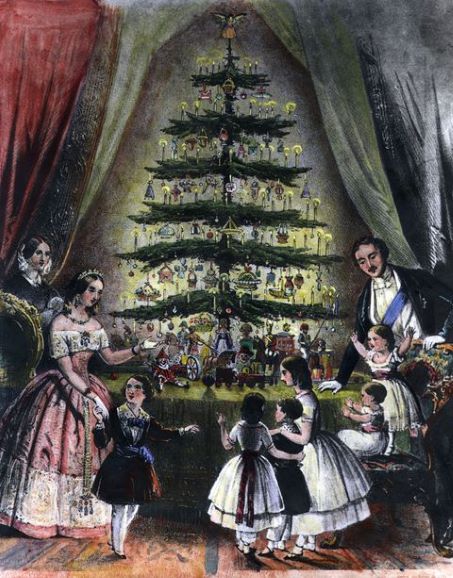
From Shunned and Rowdy to Beloved Holiday
Christmas wasn’t a welcomed tradition in the New World. The Puritans shunned the holiday because they associated it with the Church of England and Catholicism. The city of Boston even banned the celebration from 1659 – 1681. Jamestown and some of the other colonies celebrated the day, but it was often an occasion for drunkenness following the pattern from Great Britain and Europe where Christmas was celebrated with parties, drinking, and mummers (groups of people dressed in costumes going door to door entertaining and expecting gifts and food).
So how did the rowdy, shunned holiday of 17th and 18th century America become the Hallmark treasure of today?
It wasn’t until the 19th century, that two forces came together to remake and reshape the celebration in America: the Second Great Awakening and the Industrial Revolution. During the Second Great Awakening (1795 – 1835) revivals swept across the country inspiring many people to integrate their faith into their daily lives and to seek to transform their culture. This awakening gave birth to movements supporting abolition, temperance, and the emancipation of women and to a new appreciation of Christmas.
At the same time, the Industrial Revolution made the mass productions of products, including gifts, a new reality.
In addition, well-told stories captured the imaginations and hearts of the masses. Washington Irving’s Sketchbook (1819), Charles Dickens’s A Christmas Carol (1843) and Rev. Clement Moore’s “Twas the Night before Christmas” (1822) helped establish many of the traditions that carry on today, such as gift-giving, the focus on children, and the importance of family.
You’ve probably heard it said that the tradition of Christmas trees came from Germany. That is true, but it was the influence of Prince Albert of Germany that led to America adopting the tradition. When he married Queen Victoria of England in 1840, he worked to popularize the German traditions of Christmas trees, ornaments, and special wrapping paper for presents. He donated Christmas trees to schools and army barracks, but the spark that ignited the fervor that carried across the ocean was the beautiful trees he imported from Germany and decorated at Windsor Castle.
In 1848, periodicals across England publicized an engraving of one of the trees, and American publishers quickly followed suit. Suddenly, it wasn’t a proper Christmas without a decorated tree. An explosion in German immigration to the U.S. from 1840-1860 also aided in the spread of these traditions.
By the eve of the Civil War, the commercialization of Christmas was in full swing. Christmas cards flourished, and Christmas stories and songs abounded. It had become a special day for children and families.
However, for four million enslaved Americans, Christmas was bittersweet. The conclusion of the year was the time for contracts to end and begin. Some of the slaveholders leased out their slaves to work on other farms and to businesses, etc. Changes in contracts could mean separation for families. In addition, taxes were due, and some owners sold slaves in order to pay taxes.
During the Christmas season, many of the owners “treated” their slaves to presents, extra food, time off from work, and alcohol. For too many slaves, the season was a time of drunkenness. Owners encouraged the drinking as a safety valve to reduce the potential for rebellion the rest of the year.
On the other hand, some slaves treasured the season as a reminder of their spiritual freedom, that the babe in the manger was the Savior who’d welcome them to Heaven someday.
But neither slavery nor the Civil War loosened the foothold that Christmas had in the hearts of Americans.
The war separated millions of families. Men in army camps across the nation longed for the warmth and comfort of home especially on Christmas.
The industrial North was able to provide some trappings of comfort for the Federal soldiers as the war dragged on. For these soldiers, Christmas brought extra-rations and gift parcels.
In the Confederacy, the scarcity created by the war and blockades led some parents and newspapers to tell the children that Santa was a Yankee and/or that the Yankees had shot Santa, in order to explain why there wouldn’t be any presents under the tree.
For too many families who had lost loved ones, Christmas would never be the same again, but Lincoln, Grant, and others viewed Americans’ love for Christmas as a way to reunite the country, a hope that Lincoln didn’t live to see.
President Grant declared Christmas a national holiday in 1870.
Amongst all of the trappings of tinsel, lights, gifts, may we see the true gift, a Father giving his only Son that we might have life and hope everlasting. Love so amazing. Freedom from sin. Freedom to live in Him.
Source:
Stone, Ben. “Christmas and the Civil War.” National Museum of Civil War Medicine. YouTube. 13 Dec 2021.


2 thoughts on “Transforming Christmas”
This was fascinating and mostly new information to me. Thanks!
I had no idea that Queen Victoria and Prince Albert had so much influence on our Christmas traditions. And even before that, it shows how much influence stories and books like Dickens’s A Christmas Carol can have on transforming culture. Thank you for stopping by:)
Comments are closed.